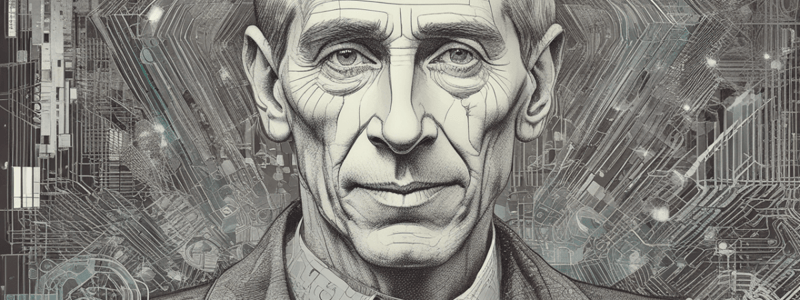Podcast
Questions and Answers
Who is considered the father of digital communication?
Who is considered the father of digital communication?
- Norbert Wiener
- John von Neumann
- Albert Einstein
- Claude Elwood Shannon (correct)
What is the primary focus of Shannon's definition of communication?
What is the primary focus of Shannon's definition of communication?
- Reproducing a message from one point to another (correct)
- The emotional impact of communication
- The physical medium of communication
- The meaning of messages
What important component does Shannon's theory use to ensure reliable communication?
What important component does Shannon's theory use to ensure reliable communication?
- Signal Amplification
- Data Caching
- Encryption
- Error Correction (correct)
In the context of data processing, what does 'unzip' refer to?
In the context of data processing, what does 'unzip' refer to?
What does 'RS' stand for in the context of error correction?
What does 'RS' stand for in the context of error correction?
Flashcards are hidden until you start studying
Study Notes
Introduction to Information Theory
- Modern digital communication is founded on Claude Elwood Shannon's 1948 paper titled "A Mathematical Theory of Communication."
- Shannon's work introduced the concept of Information Theory, addressing the challenges of reliable communication.
Shannon’s Definition of Communication
- Communication involves reproducing a message at one location that was selected from another location, either exactly or approximately.
- The meaning of messages is acknowledged but deemed irrelevant to the engineering aspects of communication.
Shannon’s Solution
- Solutions to the communication problem were proposed in Shannon's 1948 publication, shaping the foundation of Information Theory.
- The theory encompasses the processes of encoding, transmitting, and decoding messages effectively across channels.
Key Components of Information Theory
- Source: Origin of the data that needs to be communicated.
- Channel: The medium or method used for transmitting the data.
- Encoding: The process of transforming data into a suitable format for transmission.
- Decoding: The process of converting the encoded data back into its original format.
Example: Disk Storage
- Data compression is achieved through a process like zipping, while data decompression is performed by unzipping.
- CRC (Cyclic Redundancy Check): Added during encoding for error protection, allowing verification of data integrity upon decoding.
Example: VCD and DVD
- Utilizes MPEG encoding for compressing movie data and Reed-Solomon (RS) codes for error correction.
- The system consists of an MPEG encoder for encoding the data onto CD/DVD and an MPEG decoder for playback.
Importance of Error Correction
- Error protection techniques like CRC and Reed-Solomon codes are crucial for maintaining data integrity and ensuring effective communication.
Studying That Suits You
Use AI to generate personalized quizzes and flashcards to suit your learning preferences.





